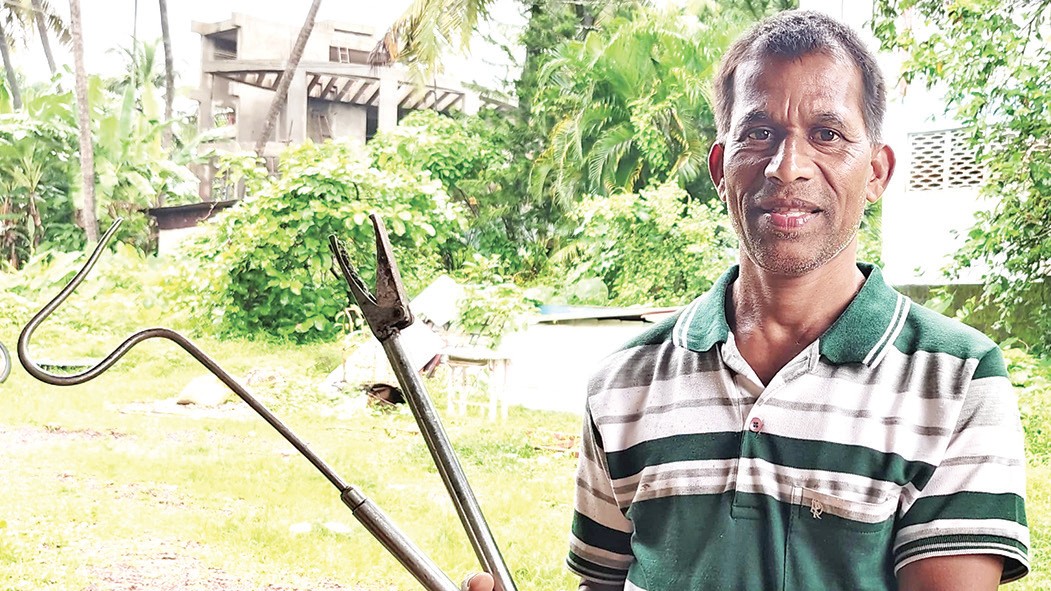

JENIFER FERNANDES
joseph@herald-goa.com
ALDONA: In Aldona, there lives a man who answers every call of distress — not to chase danger away, but to carefully carry it back to safety. Meet Vinayak Chari, 45, a fabricator by profession and a snake rescuer by passion, who has been saving lives — human and reptile — for over 15 years.
For most people, the sudden sight of a snake in their home or yard evokes fear and panic. But for Vinayak, it’s a call to action. “People are afraid because they don’t understand snakes,” he explains. “But no snake will bite you unless it feels threatened. If you stay calm and keep your distance, you’re safe.”
Over the years, Vinayak has rescued more than 1,000 snakes, including over 700 cobras, from homes, compounds, and even rooftops. Day or night, he drops whatever work he’s doing, grabs his rescue tools, hops on his bike, and rides out to help.
Vinayak learned the art of snake rescue from his elder brother, who taught him how to identify different species and handle them without harm. Equipped with nothing more than a hook, a bag, and his experience, Vinayak approaches every rescue with caution and care.
When he arrives on site, he first ensures the safety of the people. “If it’s inside the house, I ask the family to step outside. If it’s on the roof or hiding in a corner, it can be tricky. But I never rush.”
If the snake is non-venomous, he confidently picks it up by the tail and releases it back into the forest. If it’s venomous — like a cobra or krait — he uses hooks and gloves, taking no chances. “I never grab a snake by its head,” he adds. “That’s dangerous and unnecessary. Always catch it at the tail — that’s the safest way.”
Vinayak also patiently educates people about why snakes come into homes in the first place. “Snakes don’t come to harm anyone — they come looking for food, like rats or frogs. But because forests are being cut down for construction, they have no choice but to come closer to us. If we destroy their homes, where will they go?”
Vinayak emphasises that killing a snake is never the solution. Not only is it cruel, but it also disrupts nature’s balance. “Snakes have a right to live just like us. They keep rodent populations in check. They’re part of the ecosystem.”
Yet, he warns against trying to rescue a snake without proper knowledge. “People try to throw stones or chase it, and then they get bitten. You may not even know if it’s venomous or not — so always call someone experienced.”
If a snake bites you, he advises: stay calm, don’t waste time with home remedies, and rush to the nearest hospital. “Nowadays, every hospital stocks anti-venom. Just tell the doctor the symptoms, and they’ll treat you. Don’t delay.”
Vinayak and other snake rescuers like him take risks every day, yet their work often goes unnoticed. “We don’t charge for our rescues. We do it out of a sense of duty — to save both the family and the snake. But I wish the government would at least acknowledge our work and give us some support or recognition. Make us brand ambassadors of wildlife protection — it would encourage more people to come forward.”
For Vinayak, each rescue is more than a job — it’s a message of coexistence. He dreams of a day when children are taught not to fear snakes but to understand and respect them. “We should teach kids how to handle snakes properly. Show them that they are soft, smooth, and beautiful creatures, not monsters. Awareness is growing, but practical demonstrations can change minds.”
Even after all these years, Vinayak’s motivation remains the same: to protect life, in all its forms. “Every time I release a snake back into the forest, I feel proud. I know it won’t come back — despite what old beliefs say — because that’s its true home.”
He encourages children and young people to take an interest in conservation and learn the techniques of safe rescue. “Parents often discourage kids from getting involved, but someone has to continue this work. We can’t just keep killing snakes out of fear.”
For Vinayak, every call, every rescue, every life saved — human or reptile — is a testament to the fact that compassion and courage can coexist.
So the next time you see a snake, remember his words: “Stay calm, keep your distance, and call someone who knows what to do. We’re here not just to save you from the snake — but to save the snake from you.”